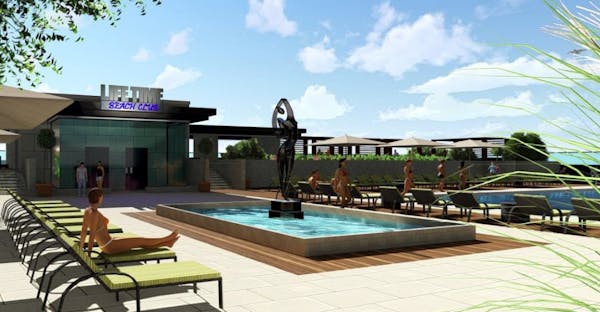In the 25 years since Bahram Akradi founded Life Time, the company has come to embody the maxim that bigger is better. He's bulked up its fleet of fitness centers to 127 across 27 states and Canada, with 14 more opening next year and another 100 expected in the next decade. Now privately held, Life Time projects revenue of about $1.6 billion in 2017 with 30,000 employees. But Akradi is looking far beyond fitness centers and recently dropped "fitness" from the company name. He's exploring healthy lifestyle villages where people shop, live, work, exercise, visit their doctor and relax at the spa. The strategy is playing out in the company's hometown of Chanhassen, where it is investing in a mixed-use development, and at Southdale Center in Edina, where Life Time will build a showpiece fitness center.
Q: Why was "Fitness" dropped from the Life Time name?
A: We always focused on building a company that's a healthy way of life for the family and the planet. The company is so much more than fitness. Life Time is more broadly descriptive of medical, sports and athletic country club. We won't drop it completely. Smaller facilities will still be called Life Time Fitness.
Q: Can your integrated concept make money?
A: I don't have to worry if we can make money on it. Not yet. We're thinking of customer satisfaction only.
Q: You've long been an admirer of the Disney brand, which is strong and distinct. Does Life Time have a distinct brand?
A: A lot of programs we have are ones we've developed — LT Proactive Care clinic, Alpha training. LT Physical Therapy, and Life Power yoga are uniquely branded. They are exclusive. It's difficult to have excellence across all these various venues. Disney does a phenomenal job as a brand. We emulate that by having each division have its own president and goal to be the best in what we deliver.
Q: What made you consider shopping malls as a location?
A: A couple of years back, we had no desire to go into a mall. But the idea is that we can re-imagine them as a healthy living and aging village with residences, entertainment, exercise, services and shops. Malls like Southdale are reapplying themselves to mixed-use. You can walk to shops, go to the health club, movie theater, and get groceries. Malls that are well-located will be a great story, not a sob story.
Q: Does being in a mall cost you more or less as opposed to a stand-alone?
A: It's complicated. It's very different in different parts of the country. It's not anything like the days when Sears or Penney's would get almost free rents, but it works better than a free-standing building.
Q: Only 3 percent of Americans can be called "fit," according to a Mayo Clinic 2016 study. Does that motivate you or make you feel as if Life Time is close to saturation?
A: We're just scratching the surface of building a whole healthy way of life with medicine, exercise and emotional-mental-physical health. The magic is in delivering all of them at a high level. Integrated medicine, that's the key. We're offering detailed, integrated instruction about how to exercise and eat. It's not being done elsewhere.
Q: Is the number of people using health clubs still rising?
A: Heathy living, aging and nutrition has been a megatrend for 40 to 50 years and it's still growing. How you get fit is changing. The way people exercise is fragmenting faster than it's growing. We work hard to adapt to the current need, and that won't change, to remain relevant.
Q: Do you ever think about going smaller, as many big-box retailers have?
A: Restoration Hardware is going bigger and more experiential. The problem with large retailers is that they grow, they do great business, and then they go public. That's an endless appetite for growth, forcing the growth and growing more than they should. Companies large and small need adaptation to keep up with change. The problem is not large vs. small. It's those that haven't changed.
Q: Twelve years ago, you said you didn't have a direct competitor. Is that still true today?
A: It's more true now than 12 years ago. With our expansion and brand extension into all aspects of healthy ways of life, we need 300 team members in a large box to have everything work properly. It takes years of recruiting just to open one location. It's so challenging that it would be very difficult to duplicate anywhere.
Q: What is your personal workout schedule and has it changed in your 50s compared to your 40s?
A: Unfortunately, it takes more work to stay leaner. I spend about four to six hours a week exercising in winter, but in the spring and summer, it's 14 to 15 hours a week. I want to be the healthiest I can be on a raw basis, not based on my age. I am 56, but I want to compare myself to a 26-year-old. I don't want to lower the standards.
